stop start RENAULT DUSTER 2016 User Guide
[x] Cancel search | Manufacturer: RENAULT, Model Year: 2016, Model line: DUSTER, Model: RENAULT DUSTER 2016Pages: 256, PDF Size: 6.49 MB
Page 77 of 256
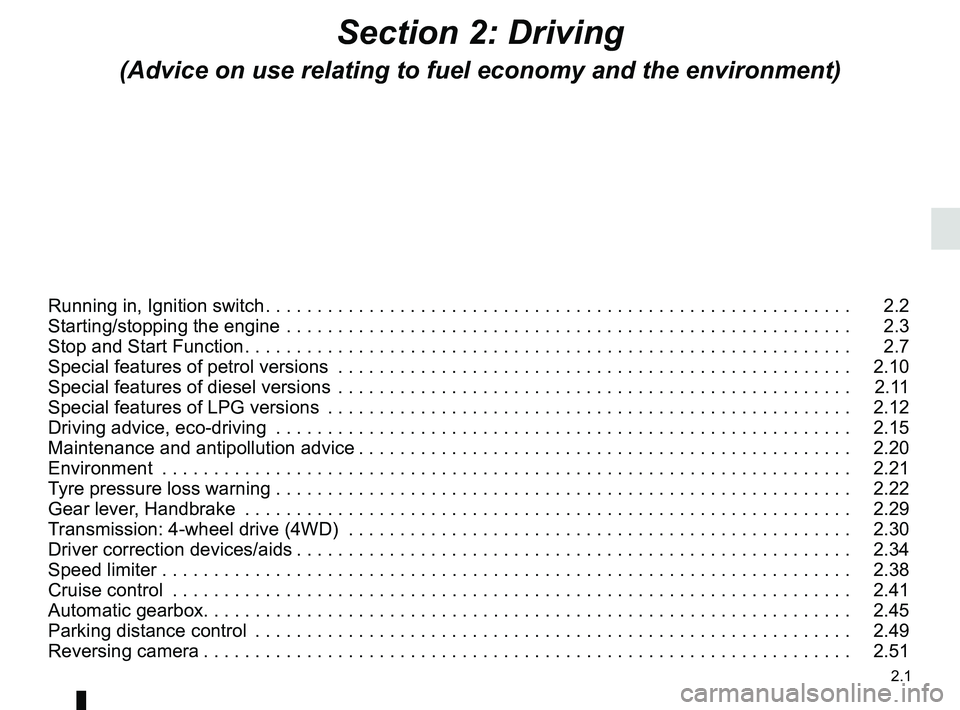
2.1
Section 2: Driving
(Advice on use relating to fuel economy and the environment)
Running in, Ignition switch . . . . . . . . . . . . . . . . . . . . . . . . . . . . . . . . . . . . \
. . . . . . . . . . . . . . . . . . . . . 2.2
Starting/stopping the engine . . . . . . . . . . . . . . . . . . . . . . . . . . . . . . . . . . . .\
. . . . . . . . . . . . . . . . . . . 2.3
Stop and Start Function . . . . . . . . . . . . . . . . . . . . . . . . . . . . . . . . . . . . \
. . . . . . . . . . . . . . . . . . . . . . . 2.7
Special features of petrol versions . . . . . . . . . . . . . . . . . . . . . . . . . . . . . . . . . . . .\
. . . . . . . . . . . . . . 2.10
Special features of diesel versions . . . . . . . . . . . . . . . . . . . . . . . . . . . . . . . . . . . .\
. . . . . . . . . . . . . . 2.11
Special features of LPG versions . . . . . . . . . . . . . . . . . . . . . . . . . . . . . . . . . . . .\
. . . . . . . . . . . . . . . 2.12
Driving advice, eco-driving . . . . . . . . . . . . . . . . . . . . . . . . . . . . . . . . . . . .\
. . . . . . . . . . . . . . . . . . . . 2.15
Maintenance and antipollution advice . . . . . . . . . . . . . . . . . . . . . . . . . . . . . . . . . . . . \
. . . . . . . . . . . . 2.20
Environment . . . . . . . . . . . . . . . . . . . . . . . . . . . . . . . . . . . .\
. . . . . . . . . . . . . . . . . . . . . . . . . . . . . . . 2.21
Tyre pressure loss warning . . . . . . . . . . . . . . . . . . . . . . . \
. . . . . . . . . . . . . . . . . . . . . . . . . . . . . . . . . 2.22
Gear lever, Handbrake . . . . . . . . . . . . . . . . . . . . . . . . . . . . . . . . . . . .\
. . . . . . . . . . . . . . . . . . . . . . . 2.29
Transmission: 4-wheel drive (4WD) . . . . . . . . . . . . . . . . . . . . . . . . . . . . . . . . . . . .\
. . . . . . . . . . . . . 2.30
Driver correction devices/aids . . . . . . . . . . . . . . . . . . . . . . . . . . . . . . . . . . . . \
. . . . . . . . . . . . . . . . . . 2.34
Speed limiter . . . . . . . . . . . . . . . . . . . . . . . . . . . . . \
. . . . . . . . . . . . . . . . . . . . . . . . . . . . . . . . . . . . . . 2.38
Cruise control . . . . . . . . . . . . . . . . . . . . . . . . . . . . . . . . . . . .\
. . . . . . . . . . . . . . . . . . . . . . . . . . . . . . 2.41
Automatic gearbox. . . . . . . . . . . . . . . . . . . . . . . . . . . .\
. . . . . . . . . . . . . . . . . . . . . . . . . . . . . . . . . . . 2.45
Parking distance control . . . . . . . . . . . . . . . . . . . . . . . . . . . . . . . . . . . .\
. . . . . . . . . . . . . . . . . . . . . . 2.49
Reversing camera . . . . . . . . . . . . . . . . . . . . . . . . . . . . . . . . . . . . \
. . . . . . . . . . . . . . . . . . . . . . . . . . . 2.51
Page 78 of 256
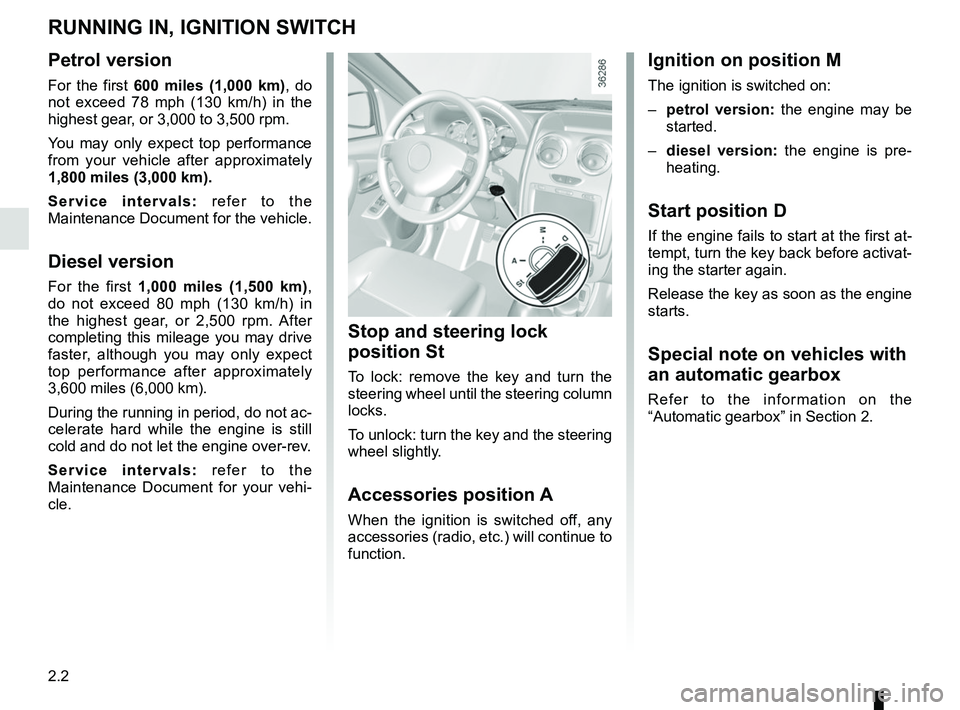
2.2
Petrol version
For the first 600 miles (1,000 km), do
not exceed 78 mph (130 km/h) in the
highest gear, or 3,000 to 3,500 rpm.
You may only expect top performance
from your vehicle after approximately
1,800 miles (3,000 km).
Service intervals: refer to the
Maintenance Document for the vehicle.
Diesel version
For the first 1,000 miles (1,500 km),
do not exceed 80 mph (130 km/h) in
the highest gear, or 2,500 rpm. After
completing this mileage you may drive
faster, although you may only expect
top performance after approximately
3,600 miles (6,000 km).
During the running in period, do not ac-
celerate hard while the engine is still
cold and do not let the engine over-rev.
Service intervals: refer to the
Maintenance Document for your vehi-
cle.
RUNNING IN, IGNITION SWITCH
Stop and steering lock
position St
To lock: remove the key and turn the
steering wheel until the steering column
locks.
To unlock: turn the key and the steering
wheel slightly.
Accessories position A
When the ignition is switched off, any
accessories (radio, etc.) will continue to
function.
Ignition on position M
The ignition is switched on:
– petrol version: the engine may be
started.
– diesel version: the engine is pre-
heating.
Start position D
If the engine fails to start at the first at-
tempt, turn the key back before activat-
ing the starter again.
Release the key as soon as the engine
starts.
Special note on vehicles with
an automatic gearbox
Refer to the information on the
“Automatic gearbox” in Section 2.
Page 79 of 256
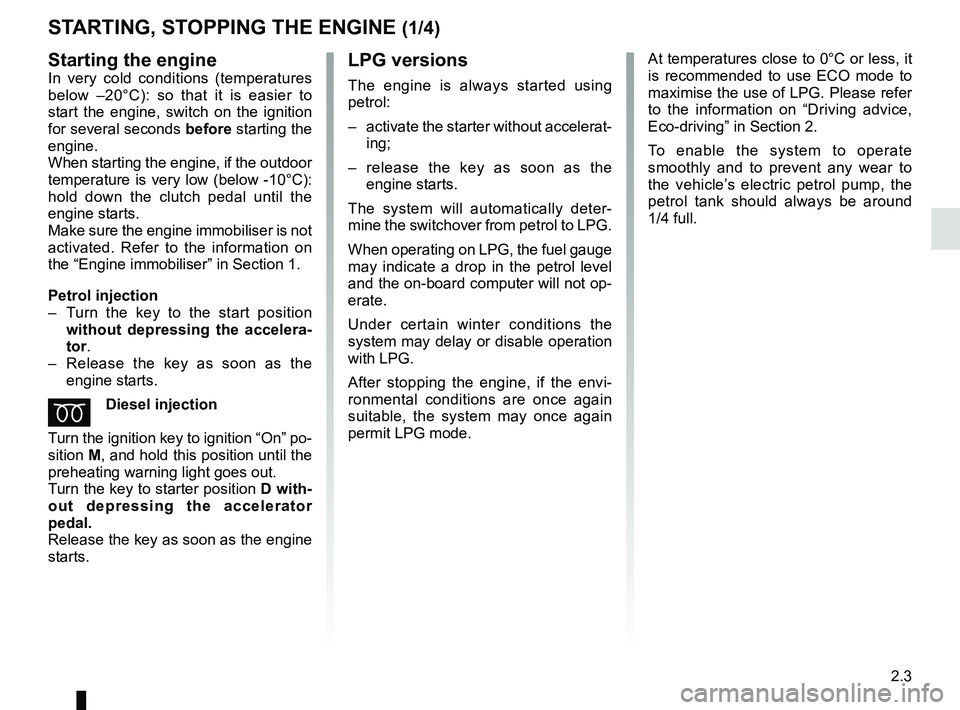
2.3
LPG versions
The engine is always started using
petrol:
– activate the starter without accelerat-ing;
– release the key as soon as the engine starts.
The system will automatically deter-
mine the switchover from petrol to LPG.
When operating on LPG, the fuel gauge
may indicate a drop in the petrol level
and the on-board computer will not op-
erate.
Under certain winter conditions the
system may delay or disable operation
with LPG.
After stopping the engine, if the envi-
ronmental conditions are once again
suitable, the system may once again
permit LPG mode.
Starting the engineIn very cold conditions (temperatures
below –20°C): so that it is easier to
start the engine, switch on the ignition
for several seconds before starting the
engine.
When starting the engine, if the outdoor
temperature is very low (below -10°C):
hold down the clutch pedal until the
engine starts.
Make sure the engine immobiliser is not
activated. Refer to the information on
the “Engine immobiliser” in Section 1.
Petrol injection
– Turn the key to the start position without depressing the accelera-
tor.
– Release the key as soon as the engine starts.
ÉDiesel injection
Turn the ignition key to ignition “On” po-
sition M, and hold this position until the
preheating warning light goes out.
Turn the key to starter position D with-
out depressing the accelerator
pedal.
Release the key as soon as the engine
starts.
STARTING, STOPPING THE ENGINE (1/4)
At temperatures close to 0°C or less, it
is recommended to use ECO mode to
maximise the use of LPG. Please refer
to the information on “Driving advice,
Eco-driving” in Section 2.
To enable the system to operate
smoothly and to prevent any wear to
the vehicle’s electric petrol pump, the
petrol tank should always be around
1/4 full.
Page 80 of 256
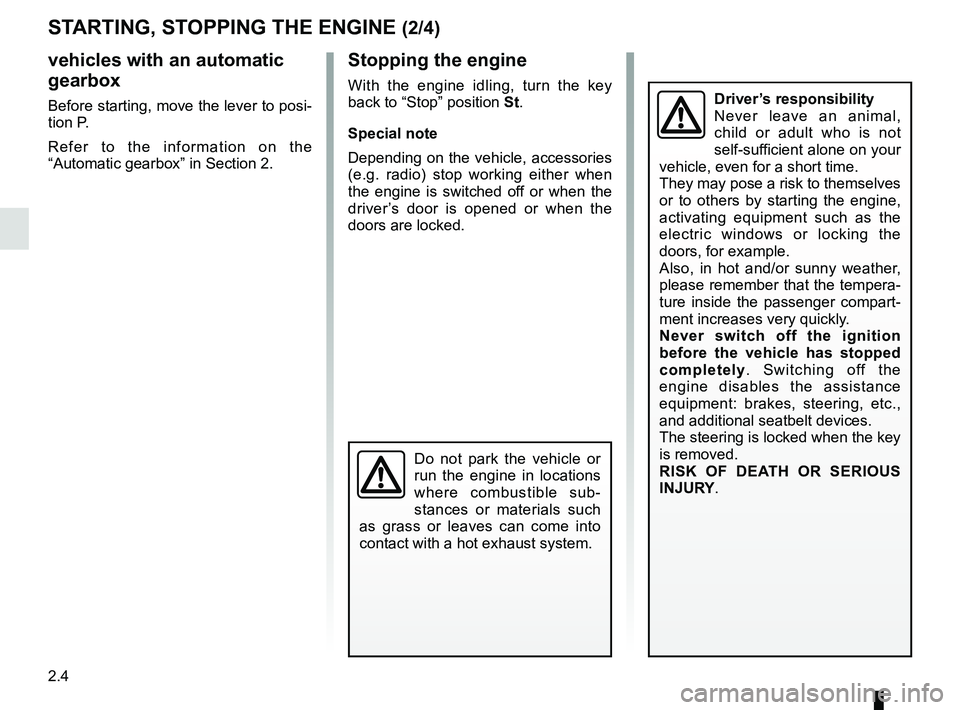
2.4
vehicles with an automatic
gearbox
Before starting, move the lever to posi-
tion P.
Refer to the information on the
“Automatic gearbox” in Section 2.
Stopping the engine
With the engine idling, turn the key
back to “Stop” position St.
Special note
Depending on the vehicle, accessories
(e.g. radio) stop working either when
the engine is switched off or when the
driver’s door is opened or when the
doors are locked.Driver’s responsibility
Never leave an animal,
child or adult who is not
self-sufficient alone on your
vehicle, even for a short time.
They may pose a risk to themselves
or to others by starting the engine,
activating equipment such as the
electric windows or locking the
doors, for example.
Also, in hot and/or sunny weather,
please remember that the tempera-
ture inside the passenger compart-
ment increases very quickly.
Never switch off the ignition
before the vehicle has stopped
completely . Switching off the
engine disables the assistance
equipment: brakes, steering, etc.,
and additional seatbelt devices.
The steering is locked when the key
is removed.
RISK OF DEATH OR SERIOUS
INJURY.
STARTING, STOPPING THE ENGINE (2/4)
Do not park the vehicle or
run the engine in locations
where combustible sub-
stances or materials such
as grass or leaves can come into
contact with a hot exhaust system.
Page 81 of 256
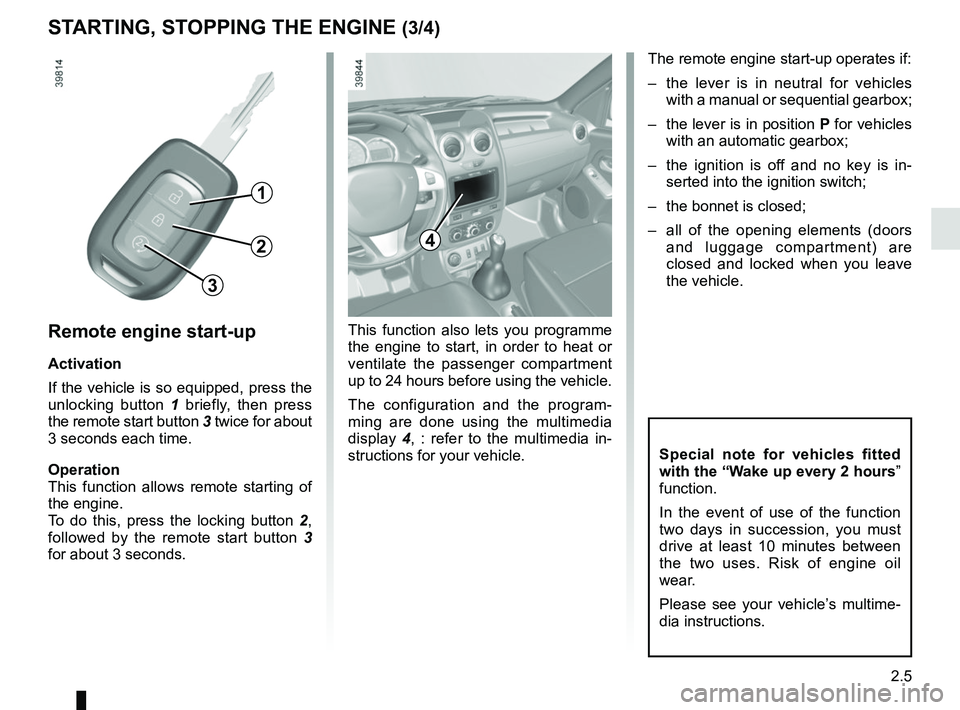
2.5
STARTING, STOPPING THE ENGINE (3/4)
Remote engine start-up
Activation
If the vehicle is so equipped, press the
unlocking button 1 briefly, then press
the remote start button 3 twice for about
3 seconds each time.
Operation
This function allows remote starting of
the engine.
To do this, press the locking button 2,
followed by the remote start button 3
for about 3 seconds.
2
3
The remote engine start-up operates if:
– the lever is in neutral for vehicles with a manual or sequential gearbox;
– the lever is in position P for vehicles
with an automatic gearbox;
– the ignition is off and no key is in- serted into the ignition switch;
– the bonnet is closed;
– all of the opening elements (doors and luggage compartment) are
closed and locked when you leave
the vehicle.
This function also lets you programme
the engine to start, in order to heat or
ventilate the passenger compartment
up to 24 hours before using the vehicle.
The configuration and the program-
ming are done using the multimedia
display 4, : refer to the multimedia in-
structions for your vehicle.
1
4
Special note for vehicles fitted
with the “Wake up every 2 hours ”
function.
In the event of use of the function
two days in succession, you must
drive at least 10 minutes between
the two uses. Risk of engine oil
wear.
Please see your vehicle’s multime-
dia instructions.
Page 82 of 256
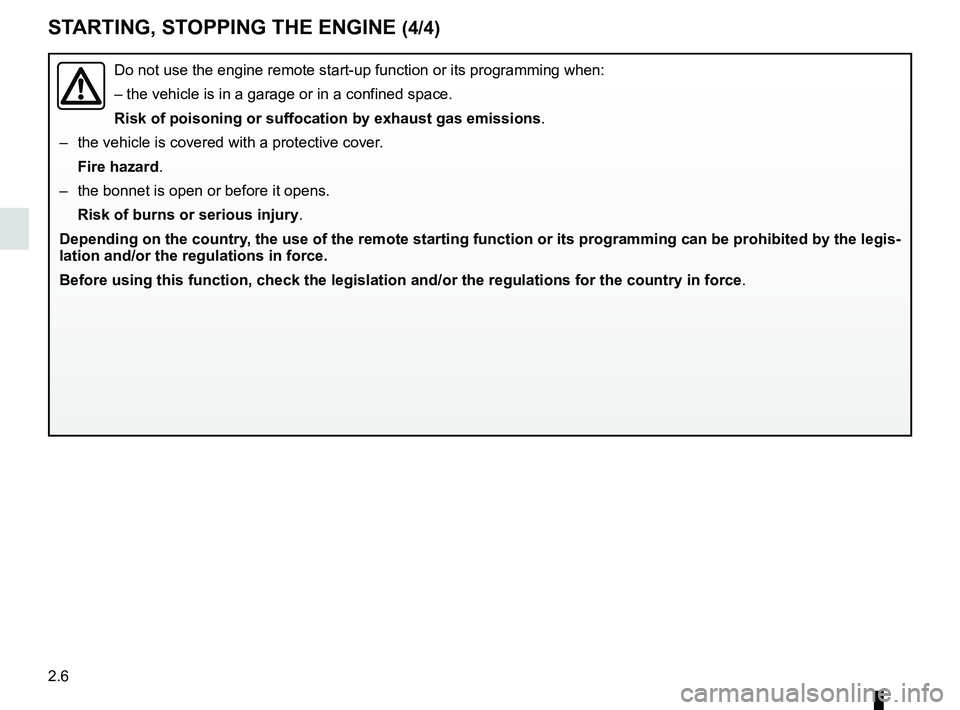
2.6
STARTING, STOPPING THE ENGINE (4/4)
Do not use the engine remote start-up function or its programming when:
– the vehicle is in a garage or in a confined space.
Risk of poisoning or suffocation by exhaust gas emissions.
– the vehicle is covered with a protective cover. Fire hazard.
– the bonnet is open or before it opens. Risk of burns or serious injury .
Depending on the country, the use of the remote starting function or its programming can be proh\
ibited by the legis-
lation and/or the regulations in force.
Before using this function, check the legislation and/or the regulations\
for the country in force .
Page 83 of 256
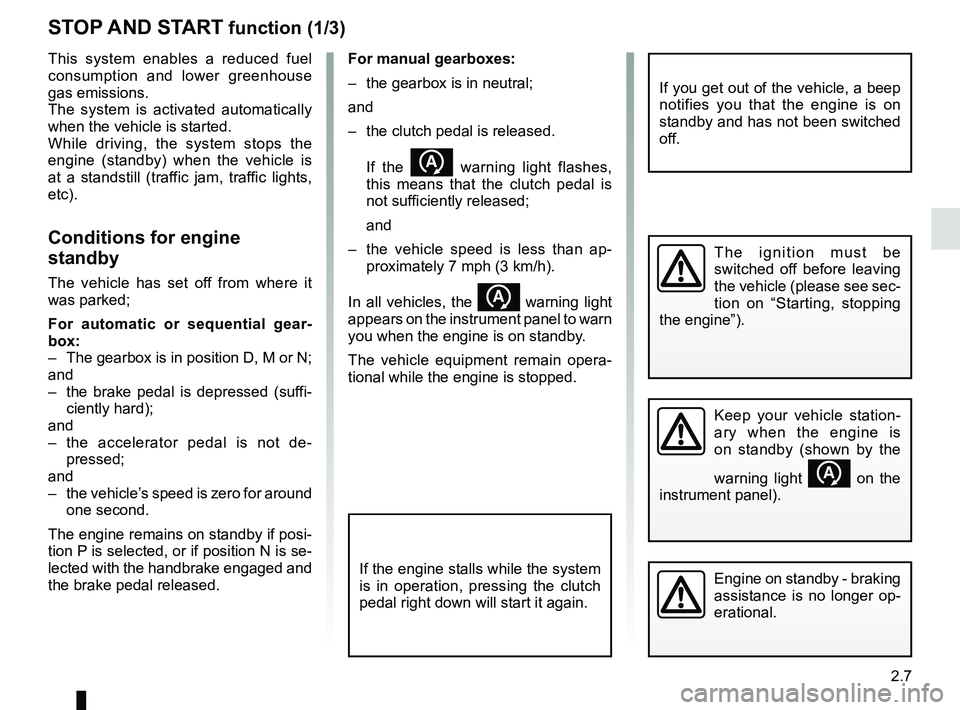
2.7
For manual gearboxes:
– the gearbox is in neutral;
and
– the clutch pedal is released.If the
warning light flashes,
this means that the clutch pedal is
not sufficiently released;
and
– the vehicle speed is less than ap- proximately 7 mph (3 km/h).
In all vehicles, the
warning light
appears on the instrument panel to warn
you when the engine is on standby.
The vehicle equipment remain opera-
tional while the engine is stopped.
STOP AND START function (1/3)
This system enables a reduced fuel
consumption and lower greenhouse
gas emissions.
The system is activated automatically
when the vehicle is started.
While driving, the system stops the
engine (standby) when the vehicle is
at a standstill (traffic jam, traffic lights,
etc).
Conditions for engine
standby
The vehicle has set off from where it
was parked;
For automatic or sequential gear-
box:
– The gearbox is in position D, M or N;
and
– the brake pedal is depressed (suffi- ciently hard);
and
– the accelerator pedal is not de- pressed;
and
– the vehicle’s speed is zero for around one second.
The engine remains on standby if posi-
tion P is selected, or if position N is se-
lected with the handbrake engaged and
the brake pedal released.
Engine on standby - braking
assistance is no longer op-
erational.
The ignition must be
switched off before leaving
the vehicle (please see sec-
tion on “Starting, stopping
the engine”).
Keep your vehicle station-
ary when the engine is
on standby (shown by the
warning light
on the
instrument panel).
If you get out of the vehicle, a beep
notifies you that the engine is on
standby and has not been switched
off.
If the engine stalls while the system
is in operation, pressing the clutch
pedal right down will start it again.
Page 84 of 256
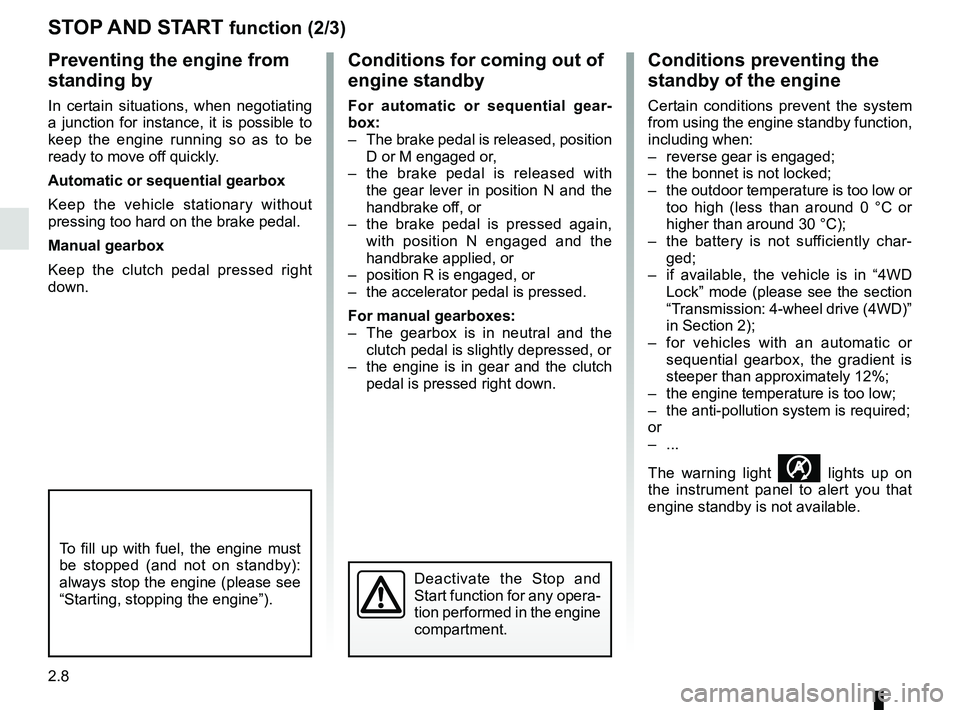
2.8
STOP AND START function (2/3)
Conditions preventing the
standby of the engine
Certain conditions prevent the system
from using the engine standby function,
including when:
– reverse gear is engaged;
– the bonnet is not locked;
– the outdoor temperature is too low or too high (less than around 0 °C or
higher than around 30 °C);
– the battery is not sufficiently char- ged;
– if available, the vehicle is in “4WD Lock” mode (please see the section
“Transmission: 4-wheel drive (4WD)”
in Section 2);
– for vehicles with an automatic or sequential gearbox, the gradient is
steeper than approximately 12%;
– the engine temperature is too low;
– the anti-pollution system is required;
or
– ...
The warning light
lights up on
the instrument panel to alert you that
engine standby is not available.
To fill up with fuel, the engine must
be stopped (and not on standby):
always stop the engine (please see
“Starting, stopping the engine”).
Deactivate the Stop and
Start function for any opera-
tion performed in the engine
compartment.
Preventing the engine from
standing by
In certain situations, when negotiating
a junction for instance, it is possible to
keep the engine running so as to be
ready to move off quickly.
Automatic or sequential gearbox
Keep the vehicle stationary without
pressing too hard on the brake pedal.
Manual gearbox
Keep the clutch pedal pressed right
down.
Conditions for coming out of
engine standby
For automatic or sequential gear-
box:
– The brake pedal is released, position D or M engaged or,
– the brake pedal is released with the gear lever in position N and the
handbrake off, or
– the brake pedal is pressed again, with position N engaged and the
handbrake applied, or
– position R is engaged, or
– the accelerator pedal is pressed.
For manual gearboxes:
– The gearbox is in neutral and the clutch pedal is slightly depressed, or
– the engine is in gear and the clutch pedal is pressed right down.
Page 85 of 256
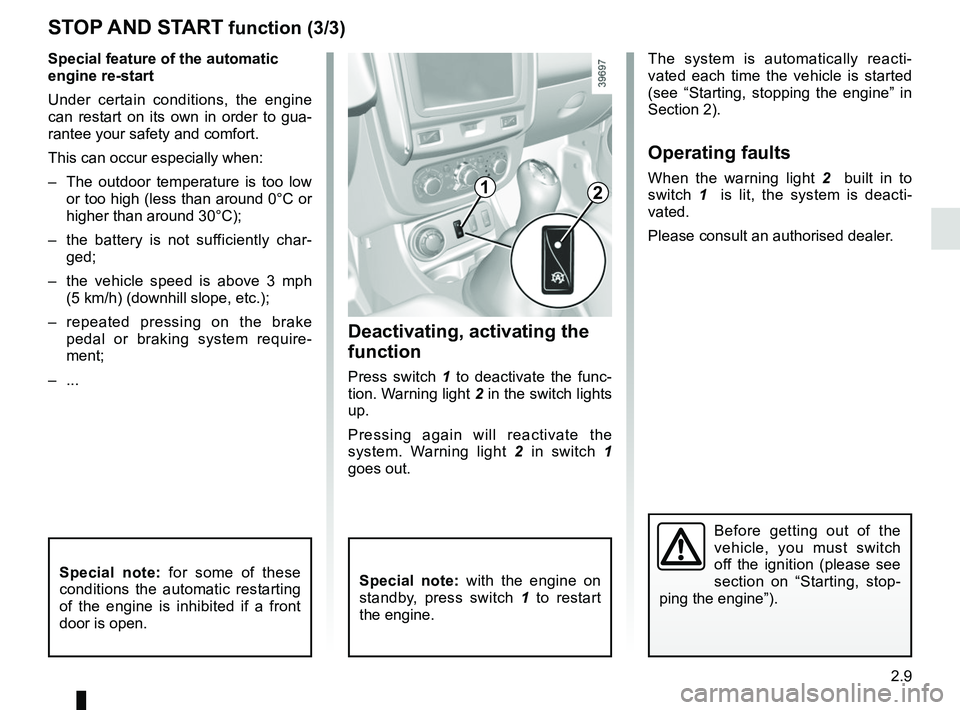
2.9
Deactivating, activating the
function
Press switch 1 to deactivate the func-
tion. Warning light 2 in the switch lights
up.
Pressing again will reactivate the
system. Warning light 2 in switch 1
goes out.
STOP AND START function (3/3)
The system is automatically reacti-
vated each time the vehicle is started
(see “Starting, stopping the engine” in
Section 2).
Operating faults
When the warning light 2 built in to
switch 1 is lit, the system is deacti-
vated.
Please consult an authorised dealer.
Before getting out of the
vehicle, you must switch
off the ignition (please see
section on “Starting, stop-
ping the engine”).
12
Special feature of the automatic
engine re-start
Under certain conditions, the engine
can restart on its own in order to gua-
rantee your safety and comfort.
This can occur especially when:
– The outdoor temperature is too low or too high (less than around 0°C or
higher than around 30°C);
– the battery is not sufficiently char- ged;
– the vehicle speed is above 3 mph (5 km/h) (downhill slope, etc.);
– repeated pressing on the brake pedal or braking system require-
ment;
– ...
Special note: with the engine on
standby, press switch 1 to restart
the engine.Special note: for some of these
conditions the automatic restarting
of the engine is inhibited if a front
door is open.
Page 90 of 256

2.14
SPECIAL FEATURES OF LPG VERSIONS (3/3)
If driving under severe
conditions
If driving under severe conditions (hea-
vily laden vehicle, high outside tempe-
rature, starting on a steep slope, etc),
you are recommended to switch to
petrol mode.
At temperatures close to 0°C or less, it
is recommended to use ECO mode to
maximise the use of LPG. Please refer
to the information on “Driving advice,
Eco-driving” in Section 2.
In the event of an accident
The main precautions to be taken are
the same as with petrol vehicles:
– apply the handbrake;
– stop the engine (a safety device that stops LPG from entering the engine
is automatically triggered);
– switch off the ignition;
– observe local regulations.
LPG has a very specific
smell so you will be able to
detect any leaks easily. If
you smell gas in your vehi-
cle or immediately surrounding your
vehicle:
– switch to petrol mode immedia- tely and make sure there are no
flames or sources of fire near the
vehicle;
– go to an authorised dealer.
Do not touch, hit or dis-
mantle any part of the LPG
system components.
Operating fault
In the event of a fault which may affect
the correct operation of the engine, the
system automatically switches from
LPG to petrol mode.
This is confirmed by:
– the appearance of the yellow war- ning light B;
– slow flashing of the green warning light D;
– a beep sounds.